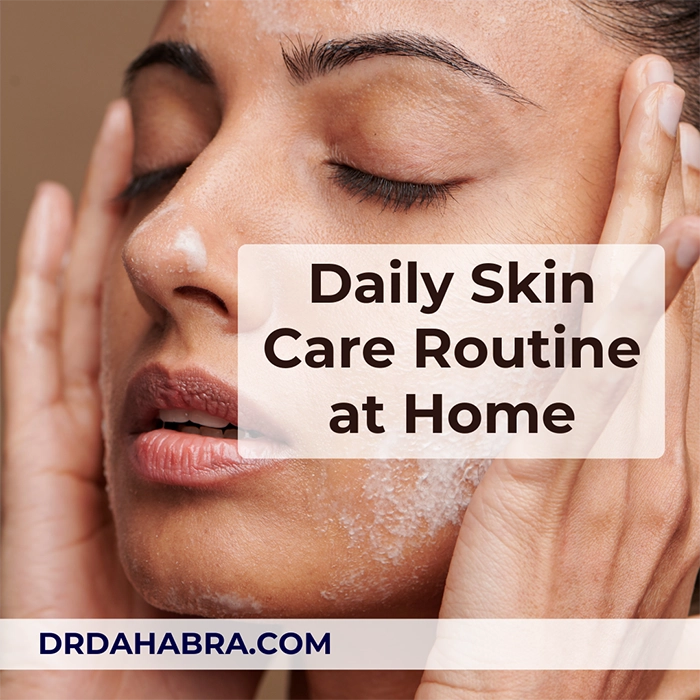The Ultimate Daily Skincare Routine at Home for Radiant Skin
Introduction to the 6 Steps to Daily Skin Care Routine at Home
Creating a daily skincare routine can feel daunting, but once you understand the basic steps and tailor them to your skin’s needs, it becomes a simple habit that can make a huge difference. This article will discuss the 6 steps to a daily skincare routine at home.
An effective routine is more than just washing your face; it’s about treating your skin kindly and giving it what it needs to stay healthy, hydrated, and radiant. Each step has a specific role, from cleansers to moisturizers and protection, and incorporating them into your day doesn’t have to be time-consuming.
Starting a routine at home also allows you to choose products and practices that suit your specific needs. This can range from selecting gentle cleansers to finding the right sunscreen.
In the long term, a consistent routine prevents skin issues like acne, dryness, and signs of aging, helping you maintain glowing skin.
Establishing this daily habit creates a foundation for long-term skin health. Think of skincare as a form of self-care that benefits your appearance, confidence, and well-being.
Table of Contents
1. The Importance of Consistency in Skincare
2. Morning vs. Evening Skincare: What’s the Difference?
Step 1: Gentle Cleansing – Choosing the Right Cleanser for Your Skin Type
Step 2: Exfoliation – How Often and How to Do It at Home
Step 3: Toning – Balancing Your Skin’s pH Levels
Step 4: Serum Application – Targeting Specific Skin Concerns
Step 5: Moisturizing – Hydration for Every Skin Type
Step 6: Sun Protection – The Essential Last Step in the Morning Routine
3. The Importance of Night Creams and Overnight Masks
4. Common Mistakes to Avoid in Your 6 Steps to Daily Skin Care Routine at Home
5. The Role of Diet and Hydration in Skincare Health
6. Natural and DIY Skincare Options for an At-Home Routine
7. Skincare Routine for Different Skin Types (Oily, Dry, Combination, Sensitive)
8. Tips for Adapting Your Skincare Routine as Seasons Change
9. Frequently Asked Questions (FAQs)
10. Conclusion
11. Transform Your Look By Following the Best Skin Care Routine at Home
12. References
1. The Importance of Consistency in Skincare
Consistency is the backbone of any skincare routine. Like most habits, skincare doesn’t produce immediate, magical results—the small, daily steps accumulate into noticeable changes over time. If you skip or frequently change products, your skin doesn’t have a chance to adjust and improve.
Committing to a schedule is crucial, whether a morning or evening routine.
By sticking to a routine, you allow your skin to become accustomed to specific products, which can increase their effectiveness. For example, if you consistently use a hydrating serum or sunscreen, your skin will continuously benefit from its protective and nourishing properties.
It’s not about expensive or complex products; it’s about regularity.
Over time, this consistency leads to a stable skin condition that is less prone to issues like acne, sensitivity, or dryness. A steady skincare routine signals to your skin that it can depend on consistent care, which makes a significant difference.
2. Morning vs. Evening Skincare: What’s the Difference?
Your skin faces different challenges during the day compared to the night, so morning and evening routines serve unique purposes.
In the morning, your skincare should focus on protection and hydration, preparing your skin to face the day’s environmental stressors, including UV rays, pollution, and stress. This typically involves cleansing, toning, moisturizing, and applying sunscreen.
The skin switches to repair mode at night, focusing on cell regeneration. Your evening routine can be more nourishing, such as heavier moisturizers or night creams, using products that assist with healing and hydration.
Cleansing is essential to remove the buildup of makeup, sweat, and pollutants, and it’s also the ideal time to apply treatments like serums or retinoids.
By separating your routine into morning and evening steps, you optimize your skin’s ability to combat stressors and rejuvenate, giving it what it needs at each part of the day.
Step 1: Gentle Cleansing – Choosing the Right Cleanser for Your Skin Type
The first and most fundamental step in any skincare routine is cleansing. Cleansing helps remove dirt, oil, and impurities that accumulate on your skin, which can clog pores and lead to breakouts or dullness.
Selecting the right cleanser is essential; it should clean effectively without stripping your skin’s natural oils. For example, those with dry skin benefit from cream cleansers, while those with oily skin might prefer gel or foaming cleansers.
When cleansing, avoid harsh scrubbing, as it can irritate the skin. Instead, use gentle, circular motions, especially in sensitive areas like the cheeks and around the eyes.
Ideally, it would help if you cleaned once in the morning to start the day fresh and once in the evening to remove buildup.
A proper cleansing routine lays a foundation for the next skincare steps, ensuring that your other products penetrate more effectively and work as intended.
Step 2: Exfoliation – How Often and How to Do It at Home
Exfoliating helps remove dead skin cells, allowing for a smoother, more radiant complexion.
Regular exfoliation can prevent clogged pores, smooth skin texture, and enhance the effectiveness of other skincare products. However, exfoliating wisely is essential; too much can lead to irritation and dryness. Most skin types benefit from exfoliating 1-3 times a week, but sensitive skin may need less.
There are two types of exfoliants: physical and chemical. Physical exfoliants, like scrubs, use small particles to buff away dead cells, while chemical exfoliants dissolve ingredients like alpha hydroxy acids (AHAs).
Overdoing exfoliation at home is easy, so using gentle, non-abrasive products is critical.
Exfoliating allows fresh, new cells to surface, promoting a healthy, radiant glow. Over time, this practice can help diminish dullness, uneven skin tone, and the appearance of fine lines.
Step 3: Toning – Balancing Your Skin’s pH Levels
Toning is often overlooked in skincare routines but can be very beneficial. A good toner helps to balance your skin’s pH levels, which cleansers can disrupt.
Our skin is naturally slightly acidic, so a toner restores this balance, preparing your skin to absorb serums and moisturizers more effectively. It also removes any leftover traces of dirt or makeup, ensuring an immaculate base.
Toners come in many types, often formulated to address specific concerns like hydration, acne, or sensitivity. Alcohol-free toners are generally recommended because they’re less drying.
Ingredients like witch hazel, rose water, or green tea extract offer soothing and hydrating benefits without the harshness of alcohol. Applying toner can feel refreshing, mainly when applied with a cotton pad or with your hands, patting it gently onto the skin.
Regular toner use can improve the absorption of other products, making your skincare routine more effective. Additionally, certain toners contain gentle exfoliants or hydrating ingredients, giving them dual functionality in maintaining healthy skin.
Step 4: Serum Application – Targeting Specific Skin Concerns
Serums are a decisive step in any skincare routine because they contain high concentrations of active ingredients that target specific skin concerns.
Whether you’re dealing with fine lines, dark spots, dryness, or acne, there’s a serum for every need. Some popular ingredients include hyaluronic acid for hydration, vitamin C for brightening, and retinoids for anti-aging.
To get the most out of a serum, apply it after toner but before moisturizer. Serums are lightweight and absorb quickly, making them ideal for layering without feeling heavy. Just a few drops are usually enough for the entire face, as serums are designed to be potent.
Using a serum consistently can significantly improve your skin’s texture, tone, and overall appearance. These targeted treatments are one of the most effective ways to address individual skincare needs and add a specialized boost to your daily routine.
Step 5: Moisturizing – Hydration for Every Skin Type
Moisturizing is essential for all skin types, including oily and acne-prone skin. A good moisturizer seals hydration, supports the skin’s natural barrier and prevents moisture loss throughout the day or night.
Moisturizers come in various forms, from lightweight gels for oily skin to rich creams for dry skin, allowing you to choose one that feels comfortable and provides the hydration your skin needs.
Applying moisturizer after serum helps lock in the active ingredients, keeping your skin supple and hydrated. Look for ingredients like glycerin, hyaluronic acid, and ceramides, which help retain moisture and strengthen the skin’s barrier.
If you’re applying moisturizer in the morning, consider a product with added SPF for sun protection.
Moisturizing not only enhances the skin’s texture and appearance but also aids in preventing premature aging. Consistently hydrated skin is less likely to show fine lines and wrinkles as it remains plump and elastic over time.
Step 6: Sun Protection – The Essential Last Step in the Morning Routine
Sun protection is one of the most critical steps in your morning skincare routine.
Sunscreen shields the skin from harmful UV rays that cause premature aging, sunburn, and skin cancer. Even on cloudy days or when indoors, UVA and UVB rays can affect the skin, making daily sunscreen application essential.
Choose a broad-spectrum sunscreen with an SPF of at least 30 for optimal protection. Many types, including mineral and chemical sunscreens, allow you to pick one that suits your skin type.
Apply it as the last step in your morning routine, ensuring an even layer over the entire face and neck.
Daily use of sunscreen can significantly reduce the risk of sun damage, preserving your skin’s health and youthful appearance over time. It’s the simplest and most effective way to prevent wrinkles, age spots, and other signs of skin damage.
3. The Importance of Night Creams and Overnight Masks
Night creams and overnight masks provide deep hydration and repair while you sleep, taking advantage of the skin’s natural regenerative process. While your day moisturizer may be light and non-greasy, night creams are more prosperous and nourishing, as they don’t need protection against external elements.
Overnight masks are another great addition, providing an intense boost of moisture or specific treatment based on your skin concerns. Ingredients like peptides, hyaluronic acid, and retinol are commonly found in night products, supporting cell turnover and collagen production.
A night cream or mask a few times a week can leave your skin feeling soft, hydrated, and rejuvenated. It’s a small addition that can yield noticeable benefits, making your skin appear more youthful and radiant by morning.
4. Common Mistakes to Avoid in Your 6 Steps to Daily Skin Care Routine at Home
While a good skincare routine can work wonders, inevitable mistakes can hinder your progress or even damage your skin.
Over-exfoliating is common, leading to irritation and weakening the skin barrier. Another mistake is not applying enough sunscreen or skipping it entirely, which exposes the skin to harmful UV rays.
Too many products can be counterproductive, especially if they contain conflicting ingredients. Mixing active ingredients like retinoids and AHAs without guidance can lead to sensitivity and redness.
Finally, skipping hydration or assuming oily skin doesn’t need moisturizer can increase oil production as the skin tries to compensate for the lack of moisture.
Avoiding these common pitfalls can help you achieve better results and ensure that each step in your routine works harmoniously.
5. The Role of Diet and Hydration in Skincare Health
What you eat and drink directly impacts your skin’s health and appearance. A diet rich in antioxidants, vitamins, and healthy fats supports skin health, while excessive sugar and processed foods can contribute to inflammation and breakouts.
Foods like berries, nuts, leafy greens, and fatty fish provide essential nutrients for glowing skin.
Hydration is equally important, as water helps flush toxins and maintain the skin’s elasticity. When you’re well-hydrated, your skin appears plumper and smoother as moisture is retained more effectively.
Combining a balanced diet with your skincare routine nourishes your skin from the inside out, giving it everything it needs to stay healthy and radiant.
6. Natural and DIY Skincare Options for an At-Home Routine
Natural and DIY skincare options are excellent for those who prefer simple, affordable, and chemical-free alternatives.
Ingredients like honey, aloe vera, coconut oil, and green tea are often used in homemade masks, cleansers, and exfoliants. These ingredients can soothe, hydrate, and brighten the skin without complex formulas.
When trying DIY skincare, use fresh, high-quality ingredients and do a patch test to avoid reactions. Natural skincare can be beneficial, but it’s important to remember that not all natural ingredients suit everyone.
Incorporating natural products into your routine can be a gentle and effective way to enhance your skincare while keeping costs low and avoiding harsh chemicals.
7. Skincare Routine for Different Skin Types (Oily, Dry, Combination, Sensitive)
Every skin type has unique needs, so a skincare routine should be customized accordingly—oily skin benefits from lightweight, oil-free products and regular exfoliation to control shine and prevent breakouts. Dry skin requires intense hydration, with creams rich in ceramides and humectants that help lock in moisture.
Combination skin needs a balanced approach, with oil control in the T-zone and extra hydration in drier areas. Sensitive skin should stick to gentle, fragrance-free products to prevent irritation, focusing on hydration and barrier repair with ingredients like ceramides and aloe vera.
Understanding your skin type allows you to select products that work harmoniously with your natural skin chemistry, making your routine more effective and minimizing potential irritation.
8. Tips for Adapting Your Skincare Routine as Seasons Change
Your skincare needs can vary with the seasons. In winter, cold air and indoor heating can dry out your skin, so a richer moisturizer and hydrating masks may be necessary.
However, summer often requires lighter products, increased exfoliation, and frequent sunscreen application due to higher UV exposure.
Humidity levels, temperature, and sun exposure affect skin behavior, so adapting your routine helps maintain balance. Simple changes like adding a hydrating serum in winter or switching to a mattifying moisturizer in summer can make a big difference.
Adapting to seasonal changes helps keep your skin healthy and resilient throughout the year, ensuring you’re always giving it what it needs based on environmental factors.
9. Frequently Asked Questions (FAQs) about The Daily SkinCare Routine at Home
Q1. What’s the most essential step in a skincare routine?
Concise Answer: Cleansing is often considered the most crucial step.
Detailed Answer: Cleansing removes dirt, oil, and impurities from your skin, preventing clogged pores and setting a clean foundation for your other skincare products to work effectively. It ensures that everything you apply afterward can penetrate and perform at its best.
Q2. How often should I exfoliate?
Concise Answer: Exfoliate 1-3 times a week, depending on your skin type.
Detailed Answer: Exfoliating once or twice weekly is typically sufficient for most skin types, while oily or acne-prone skin may tolerate up to three times. Over-exfoliating can lead to sensitivity and dryness, so adjust based on how your skin feels.
Q3. Can I use the same skincare products in the morning and at night?
Concise Answer: Specific morning and night products may enhance effectiveness.
Detailed Answer: While some products, like cleansers and moisturizers, can work well both morning and night, certain products are better suited for specific times. For example, SPF should be used only in the morning, while treatments like retinol are generally recommended at night to maximize benefits without sun sensitivity.
Tailoring your products to morning and night routines can help optimize your skincare results.
Q4. How can I tell what skin type I have?
Concise Answer: Check your skin’s oil levels and texture after washing and throughout the day.
Detailed Answer: To determine your skin type, cleanse your face and avoid applying any products. After about an hour, observe your skin’s feel and appearance.
Oily skin will shine across the face, dry skin will feel tight, combination skin will show oiliness in the T-zone, and normal skin will feel balanced.
Sensitive skin may experience redness or irritation easily. Knowing your type helps you select the best products for your routine.
Q5. What does a toner do, and do I need it?
Concise Answer: Toners balance skin’s pH and prep it for better absorption of other products.
Detailed Answer: Toners can be beneficial, especially for balancing the skin’s pH after cleansing, which is essential if your cleanser is harsh or stripping. They help remove leftover impurities and prepare your skin for serum and moisturizer.
While not everyone may need it, a toner can add an extra boost, especially for oily, acne-prone, or sensitive skin types when chosen wisely.
Q6. How do I layer my skincare products properly?
Concise Answer: Apply products from thinnest to thickest consistency for optimal absorption.
Detailed Answer: Start with cleansers, then apply toner, serums, and moisturizers. Lightweight products like serums should come before thicker creams, as this order allows each product to penetrate effectively.
Sunscreen is always the last step in the morning routine. Layering correctly helps your skin absorb active ingredients, making each product work efficiently without blocking others.
Q7. Is it okay to skip a step in my skincare routine?
Concise Answer: Yes, but some steps like cleansing and moisturizing are essential.
Detailed Answer: Skipping occasional steps is usually acceptable and sometimes necessary if your skin feels overloaded. However, cleansing and moisturizing are foundational for clean, hydrated skin.
If you must skip, keep sunscreen and hydration in your routine. Adapt your routine to your needs, but avoid skipping complete essential steps consistently for best results.
Q8. How often should I change my skincare products?
Concise Answer: Based on skin response and seasonal changes, change products as needed.
Detailed Answer: If a product works well, you only need to switch if your skin’s needs change due to season, age, or a shift in skin concerns.
On average, trying new products every six months to a year can refresh results, but listen to your skin; if you’re noticing issues or reduced effectiveness, it may be time for a switch.
Q9. Are expensive skincare products better than affordable ones?
Concise Answer: Not necessarily; effective products exist at all price points.
Detailed Answer: Price only sometimes correlates with quality, as effective ingredients and formulations are available across price ranges.
Luxury products often include high-quality ingredients and proprietary formulas, but many affordable brands deliver excellent results, too. Focus on ingredients and reviews rather than price to find what works for you.
Q10. What’s the best way to treat acne at home?
Concise Answer: Use gentle, targeted treatments like salicylic acid and keep skin clean.
Detailed Answer: Start with a gentle routine, avoiding harsh scrubs that can worsen irritation. In treatments, look for acne-targeting ingredients such as salicylic acid, benzoyl peroxide, or tea tree oil.
Consistency is vital; apply products as directed, and avoid touching or picking at the skin. Keeping pillowcases clean and managing diet can also help control breakouts over time.
Q11. Can I use natural ingredients as part of my skincare routine?
Concise Answer: Yes, but ensure they’re safe for skin use and suited to your skin type.
Detailed Answer: Many natural ingredients can benefit the skin when appropriately used; honey has antibacterial properties, and aloe vera is soothing.
However, not all natural products are gentle—citrus oils, for instance, can irritate. Always research ingredients and do a patch test, particularly for DIY skincare, to avoid adverse reactions.
Q12. How does hydration impact my skin?
Concise Answer: Proper hydration improves skin texture, elasticity, and overall health.
Detailed Answer: Hydration affects how the skin looks and feels. When adequately hydrated, skin is plumper, smoother, and better able to repair itself. Lack of hydration can cause dullness, dryness, and fine lines.
Drinking enough water and using hydrating products with ingredients like hyaluronic acid are vital to maintaining skin moisture and health.
Q13. Should I use different products for day and night?
Concise Answer: Day products focus on protection, while night products support repair.
Detailed Answer: During the day, focus on hydration and protection, especially sunscreen. At night, the skin regenerates, so heavier moisturizers, serums, and treatment products work best.
Ingredients like retinol are typically reserved for nighttime as they make skin more sun-sensitive. This approach lets your skin handle different needs at different times.
Q14. Is it necessary to use a face mask regularly?
Concise Answer: Regular use of face masks can target specific skin concerns effectively.
Detailed Answer: Masks aren’t essential daily, but incorporating them once or twice a week can add benefits, such as deep hydration, oil control, or brightening, depending on the type of mask.
They can boost your routine, especially if your skin needs extra nourishment or purifying treatment. Regular but not excessive mask use is recommended for a balanced routine.
Q15. Can I use multiple serums in my routine?
Concise Answer: Yes, but avoid layering conflicting active ingredients without guidance.
Detailed Answer: Using multiple serums can enhance your routine if applied correctly. For instance, a hydrating serum with hyaluronic acid can complement an anti-aging serum with peptides.
However, some ingredients like retinol and AHAs should be distinct. Apply serums in order of thickness, and introduce new combinations slowly to monitor your skin’s reaction.
10. Conclusion: 6 Steps to Daily Skin Care Routine at Home
Incorporating a consistent and effective daily skincare routine at home is an investment in your appearance and self-care routine. Each step, from cleansing to sun protection, plays a specific role in maintaining healthy, radiant skin, which many of us aim for.
By understanding and following a structured skincare routine, you empower your skin to function at its best, combating dryness, acne, and even the signs of aging more effectively.
Remember, the best results come with time and consistency. This routine doesn’t need to be complex or expensive to be effective; it just needs to be tailored to your skin’s unique needs.
With commitment and patience, you’ll likely see a significant improvement in your skin’s health and glow, making it well worth the effort.
We have covered everything about the 6 steps to daily skin care routine at home.
11. Transform Your Look By Following the Best Skin Care Routine
Experience the revolutionary power of the best skincare routine at home in Florida. Our state-of-the-art treatment revitalizes and rejuvenates, offering you a path to radiant, youthful skin. Why wait to unlock your best self?
Call us now at (954) 595-2607 or book online. Your journey to flawless skin begins with just a click or a call.
Embrace the beauty, embrace innovation – Embrace You.
12. References
- Dr. Chadi Dahabra
- Plantation Med Spa
- West Palm Beach Med Spa
- Beverly Hills Wellness Center & Med Spa
- Topical exfoliation-clinical effects and formulating considerations
- Clinical evidences of benefits from an advanced skin care routine in comparison with a simple routine
- Impact of pH Balance in Skincare – Science Direct




